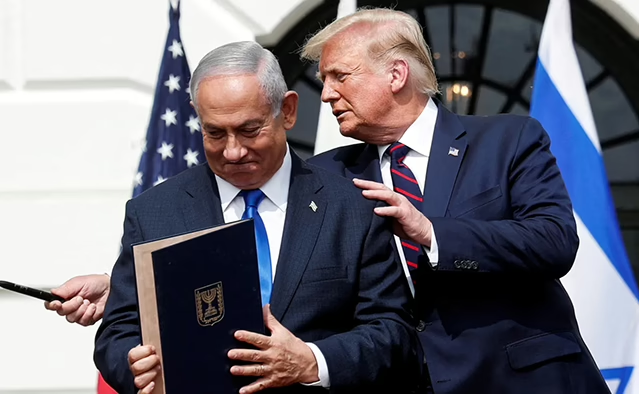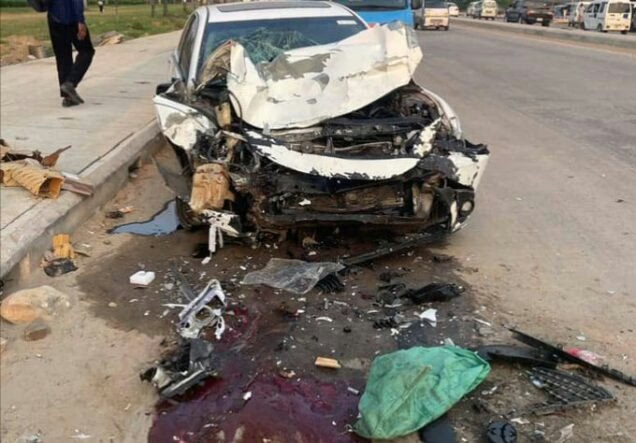… Can Netanyahu Survive Without War?
In the days since the January 19 cease-fire in Gaza, many Israelis have found themselves in an emotional storm almost as powerful as the shock of Hamas’s October 7, 2023, massacre. The difference, of course, is that this time the storm is driven not by sorrow and unspeakable horror but by joy and—for the first time in more than 15 months— the possibility of hope. Already, the fragile deal has come under considerable stress, and it could collapse in the weeks to come. Yet for the time being, the fighting has stopped in both Gaza and Lebanon, and hostages have begun to come home. As shown by the outpouring of reactions on social media and in the Israeli press, the vast majority of Israelis have greeted the deal as a cause for celebration—even those who opposed it for strategic or ideological reasons.
But the overwhelming response is not primarily about peace. Far more, it is about what the deal means for Israel’s embattled identity. The core issue for Israelis, which may not be fully grasped by outside observers, is that ever since the establishment of Israel in 1948, three years after the end of the Holocaust, the country has defined itself by its status as a safe haven for Jews. For more than 70 years, despite major wars and frequent challenges, it was able to maintain this foundational ideal. With the October 7 attacks, however, that status was ruptured. The belief that the army and other security agencies would always arrive in time to save Jews in distress was completely shattered. And for many Israelis, this failure persisted throughout more than 15 months of war, as the government proved unable to rescue or return a large number of the 251 hostages—Israelis and foreigners—that had been taken to Gaza.
Now, Israel has finally begun to repair these broken foundations. At the time of the cease-fire, there were 97 Israeli hostages—civilians and soldiers—about half of whom are believed to be alive. Seven, all of them women, have been released so far, and 26 more are to be returned in small groups over the next four and a half weeks. For many Israelis, the government and security forces can never atone for the lapses that allowed October 7 to happen. But the hostage deal does restore hope for the first time since the war began that the safe haven can be rebuilt to some extent.
Yet the deal comes at a high price. In exchange for the first 33 hostages, Israel has agreed to release approximately 1,700 Palestinian prisoners, including more than 200 who are serving life sentences for murdering Israelis. And that is only the first round of concessions. Once “Phase One” is completed, 64 hostages will still remain in Gaza, fewer than 30 of whom are believed to be alive. Their release will require the freeing of thousands more Palestinian prisoners, including many who are serving multiple life sentences. Those freed will also include prisoners whom Israelis view as “terrorist celebrities”—high-ranking figures in Palestinian militant groups responsible for orchestrating mass-casualty suicide bombings in the 1990s and the first decade of this century. These are prisoners no Israeli government has ever agreed to release before.
For Israeli Prime Minister Benjamin Netanyahu, all this presents a huge dilemma. He needs his far-right coalition partners to stay in power. But they adamantly oppose the cease-fire and—in contrast to a large majority of the Israeli public— are demanding that the war restart or they will resign. If new elections were held today, Netanyahu would probably lose. At the same time, the prime minister must also now contend with U.S. President Donald Trump, who is applying enormous pressure to get things done his way and says he will not tolerate having the war continue on his watch. Netanyahu is expected to meet Trump at the White House in early February.
What happens next, then, will depend primarily on the U.S. president. The incoming administration has big plans. For many months, Trump’s aides and advisers have been speaking about the regional arrangements Trump wants to establish. His main goal seems to lie in multibillion dollar technology and defense deals between the United States and Saudi Arabia. An accompanying step would be a grand Israeli-Saudi normalization deal, similar to the one the Biden administration tried to push through in the fall of 2023. (Hamas leaders later described thwarting that deal as one of their motivations for launching the October 7 attacks.) In order to achieve these goals, Trump will need the cease-fire in Gaza, along with its counterpart in Lebanon, to hold as long as possible—whether or not both sides are really interested in peace.
War Gone Wrong
The story behind the Gaza cease-fire is almost as long as the war itself. In November 2023, after concluding that the large number of women and children they had abducted were more of a liability than a strategic asset, Hamas’s leaders negotiated the first cease-fire for hostage deal with Israel, mediated by Egypt, Qatar, and the United States. At the time, Hamas hurried to offload those hostages in exchange for a negligible benefit compared to past such deals—three Palestinian prisoners, mostly women and minors, were released for every Israeli hostage.
In theory, after seven days, the initial exchange was supposed to lead to a second phase, in which the cease-fire would be extended and the remaining hostages would gradually be released in exchange for a higher price from Israel. But negotiations stalled on the seventh day, and contrary to the mediators’ expectations, fighting resumed, and the Israel Defense Forces (IDF) relaunched its massive ground invasion into central Gaza. Soon, that campaign expanded into the southern areas of the strip.
Advertisement
In the following months, despite repeated efforts, negotiations toward a new deal broke down. By May 2024, the Biden administration was so frustrated by the lack of progress by the Israeli government that President Joe Biden took the extraordinary step of announcing a cease-fire for hostage deal that he said had been approved in private by Israel. But Netanyahu nixed it. (In fact, it was essentially the same deal to which Israel has now agreed.) Still, throughout his final year in office, Biden generally provided Netanyahu with cover, mostly blaming Hamas for the breakdown of talks.
Many of the members of Israel’s own negotiating team, however, knew otherwise. They suspected Netanyahu was deliberately sabotaging the talks whenever they neared fruition, because he feared that his far-right coalition partners, Ministers Bezalel Smotrich and Itamar Ben-Gvir, would resign if the agreement were implemented. And if the government collapsed, Netanyahu himself faced growing legal jeopardy in the three corruption cases against him. Thus, by continually stonewalling a deal, the prime minister seemed to be prioritizing his own political and personal survival over bringing the hostages home.
Meanwhile, the government’s continued failure to secure a deal produced a growing outcry among large segments of the Israeli public, led by the families of the hostages. In Tel Aviv, tens of thousands of people gathered in weekly protests, and a major square near the IDF headquarters was renamed “Hostages Square.” Hostage families and protest activists frequently blocked major roads. In every Israeli community, symbolic and less confrontational protest initiatives also emerged, such as displays of empty plastic chairs, yellow ribbons, and posters with giant photos of the hostages and the words, “What if it were your daughter?” The faces and personal stories of the hostages became familiar in almost every Israeli home, with many adopting a particular hostage to champion. The government’s apparent indifference toward the hostages—despite the IDF’s near-total military control of Gaza and the fact that many hostages were held within a few kilometers of IDF positions—only deepened the public’s frustration.
Throughout the entire span of the war, the military succeeded in rescuing just eight hostages from Gaza— only about three percent of the total. Meanwhile, dozens more were found dead, hidden by Palestinians in various locations within the strip. These results are astonishingly poor for a country that has long prided itself on its bold rescue missions. Consider the 1976 Entebbe operation, the raid in Uganda by Israeli commandos—and the raid in which the prime minister’s elder brother, Lieutenant Colonel Yonatan Netanyahu, was killed: the operation succeeded in rescuing 102 of the 106 hostages held by Palestinian militants. In the decades since, the risks involved in such operations have grown, for both the elite Israeli rescue forces and the hostages themselves.
As the war in Gaza dragged on without a deal, hope for the hostages diminished further. In June 2024, after Israeli forces rescued four hostages from the Nuseirat refugee camp in central Gaza, Hamas changed its instructions to hostage guards: if they detected any Israeli military activity nearby, they were told, they should execute the hostages to prevent their liberation. Two months later, this tragically occurred, when the captors of six Israeli civilians, after hearing the movement of IDF armored vehicles above them, murdered them. Among the victims was Hersh Goldberg-Polin, a young Israeli-American whose family’s extensive advocacy for his release elicited significant responses in Israel and the Western world. It was hard for many Israelis not to see this as the result of a failed war.
Trump Or A Hard Place
If the January 19 cease-fire has signaled a possible turning point, Israel’s crisis of confidence is a long way from being repaired. Israeli society is sharply polarized, and Netanyahu’s divisive persona will complicate the rebuilding process. Additionally, the government’s inability to make good on its promise to achieve “total victory” over Hamas despite the IDF’s overwhelming battlefield advantage and Netanyahu’s refusal to permit an independent investigation into the failures leading to October 7 pose substantial roadblocks to any national reconciliation.
Moreover, as part of the cease-fire, the government has made other significant concessions. The IDF has withdrawn from the security corridor it created in the center of Gaza to split the north and the south, and it has committed to withdrawing from the so-called Philadelphi corridor along Gaza’s southern border with Egypt, near Rafah, in the seventh week of the cease-fire. Israel will almost certainly insist on retaining some form of military presence in what it calls the security perimeter—a buffer zone extending about a kilometer beyond the border fence into Palestinian territory along the entire border.
These concessions, along with the release of Palestinian prisoners, have drawn harsh criticism from not only the far-right parties but also Netanyahu’s core supporters. Take Channel 14, the pro-Netanyahu TV network that resembles a mix of Fox News and Newsmax. Throughout the war, the network deflected all questions about the prime minister’s culpability for the catastrophic security failures on October 7 and justified every decision he made since then. But the reality of the cease-fire and the unprecedented concessions it has involved has upturned the Channel 14 narrative. Now, the network’s usual pro-government propaganda has given way to theological debates between loyalists and those who are suddenly critical. “If this were an agreement brought by [the former Israeli prime minister and current opposition leader] Yair Lapid, I would have opposed it,” admitted one of the journalists. “But since it’s Netanyahu, I support it.” Others on the right are more strident, calling the deal an “embarrassing surrender.”
Continues in FOREIGN AFFAIRS (www. foreignaffairs.com), January 29, 2025.











